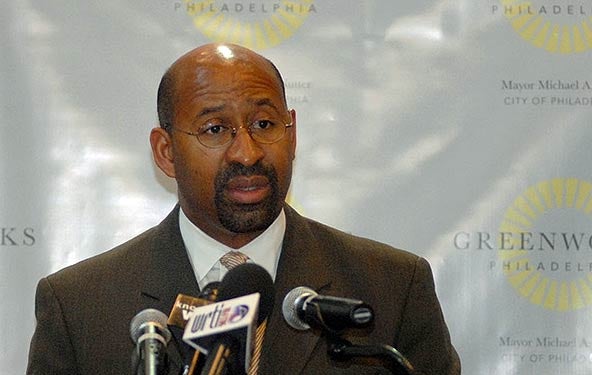It’s a green scene for the city

April 29, 2009
By Kellie Patrick Gates
For PlanPhilly
Mayor Michael Nutter Wednesday unveiled a plan designed to make Philadelphia the nation’s greenest city by 2015.
If the goals of Greenworks Philadelphia are met, city government will reduce its energy consumption by 30 percent and save $36 million annually as a result, Nutter said.
Twenty percent of the energy used in the city will come from alternative sources, he said, noting that the solar panels perched on the roof of the Riverside Correctional facility are a start in that direction.
The volume of recycled materials would increase by 25 percent. Plastic bags would disappear, but more green space would pop up across the city, so that every resident was no more than half a mile or a 10-minute walk from a park or green area.
The plan calls for planting 300,000 trees over the next 7 years, encouraging the growth of urban farms to provide more access to fresh fruits and vegetables and weatherizing homes.
This initiative will need workers, Nutter said, as he stood below a huge statue of Ben at the Franklin Institute, where the announcement was made. The U.S. Conference of Mayors estimates that there are now 14,000 green jobs in the city, he said, and the goal is now to add 15,000 more by 2015.
“We will put people to work, because we have so much work to do in our city,” he said. “Green jobs represent a new pathway to the middle class, just as factory jobs once were,” Nutter said.
City sustainability director Mark Alan Hughes likened the significance of the changes to come as a result of more limited fossil fuel energy to the changes that sprung from the invention of the Model T.
Just like that invention led to the need for more roads and stoplights – and people to build those things – the green economy will lead to innovations and employment in areas that people haven’t even thought of yet.
Nutter said the walkable neighborhoods and public transportation structure that Philadelphia still has, despite the collapse of its old industries, have left it in a very good position to capitalize on the new green economy. Other cities have or will spend many millions of dollars trying to replicate what Philadelphia already has, he said.
Greenworks was assembled over the past 10 months with input from city employees, nonprofits and civic and business leaders, including the mayor’s Sustainability Advisory Board. The plan includes about 170 initiatives.
Nutter was introduced by Van Jones, White House special adviser for green jobs, enterprise and innovation. Nutter said it was fitting that Greenworks was announced on the 100th day of the Obama Administration, because much of what the plan contains could not happen without the federal economic stimulus money. Jones said that the initiative has Obama’s support.
Jones said he didn’t mind leaving Washington on a very big day for the federal administration. “I cleared my calendar to be here, because I have a good sense of history being made,” he said. Jones predicted that the Philadelphia plan would be a model for other cities to follow in these tough economic times. “You are putting a green star in a dark sky,” he said.
Before the press conference started, Hughes said that despite the size of Greenworks Philadelphia, the initiative brings no additional cost to taxpayers.
Some of the initiatives, such as the weatherization of homes, will be paid for with new state or federal funds, Hughes said. In some cases, he said, the city will be using money it now spends in an old way to address the same problems, but in a new, greener way. For example, rather than increasing the capacity of the sewer system to handle rain water, more green space can be created to absorb that water so it never reaches the system, he said. And some green programs – such as providing residents with incentives to recycle – are already part of the budget.
Hughes said that in the long run, greener will be cheaper. The city spends money to entice residents to recycle, he said, but the city comes out ahead when it sells those recyclables rather than paying landfill costs. Even now, when the market for recycled goods has tanked, it costs less for the city to pay to store recyclables than it does to put that material in a landfill, he said.
Speaking of recyclables, anyone who wonders what to do with bottles, cans and the like while walking Center City’s streets will soon have a handy place to put them – and their non-recyclable trash.
The first of 250 recycling containers and 500 solar-powered, compacting trash cans will be in place in June, said Deputy Mayor for Transportation Rina Cutler.
Workers must empty regular public trash cans 17 times each week, Hughes said. The solar powered cans that compact the trash will only need to be emptied five times a week, and that cuts labor costs, he said.
If the program works well, it may be expanded to other parts of the city, Cutler said. And because the cans are capped, she said, they will not smell.
The full Greenworks Philadelphia report, and a short video about the program, are posted here.
Contact the reporter at kelliespatrick@gmail.com
WHYY is your source for fact-based, in-depth journalism and information. As a nonprofit organization, we rely on financial support from readers like you. Please give today.



